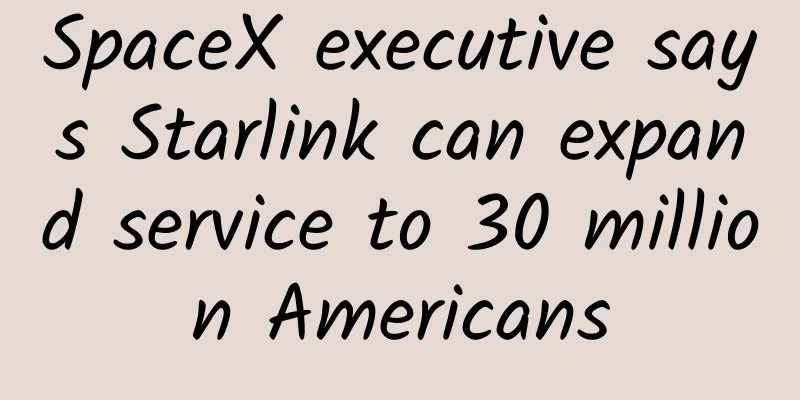SpaceX executive says Starlink can expand service to 30 million Americans

|
SpaceX's satellite internet service, Starlink, will not completely rule out providing coverage in urban areas, though it aims to optimize service in rural and underserved areas, according to a report filed earlier this month by David Goldman, SpaceX's director of satellite policy, with the Federal Communications Commission.
In the latest presentation, SpaceX executives outlined to the committee how the internet service could scale up operations to provide data connectivity to 30 million Americans who currently have no internet coverage or no service. He also criticized research on satellite communications by companies such as RS Access, saying it made overly restrictive assumptions about satellite internet, used "pirate" information and used data that did not represent real-world performance. Starlink claims that MVDDS licensees are "spectrum hoarders" who do not provide useful consumer services. Goldman's comments came in the form of a presentation made during a meeting with commission officials earlier this month, in which the SpaceX executive took aim at a study submitted by RS Access and conducted by RKF Engineering Solutions that was intended to demonstrate that multi-channel video data distribution (MVDDS) service providers and non-geostationary fixed satellite service (NGSO FSS) providers could use the 12 GHz band without significantly impacting each other's services. The study was designed to refute a study submitted by DISH several years ago that claimed satellite companies could not coexist with other companies in the 12 GHz band. However, Goldman believes that it is flawed in several ways because it relies on spoofed data, false rural and urban divisions, inaccurate assumptions, and ultimately depicts significant interference from MVDDS providers to satellite internet users. In response to the RS Access study, SpaceX's Goldman said the report severely underestimated future demand for satellite internet. One assumption used in the RKF study is that even if Starlink employs 2.5 million user terminals, interference from MVDDS 5G providers will be minimal because the satellite terminals will serve rural areas and the 5G terminals will be in urban areas. In a detailed rebuttal to the study, SpaceX’s Goldman refuted this assumption, saying: Of the 2.5 million user terminals modeled (a lower estimate that is not entirely accurate), only 14,600 are placed in “metropolitan” RDAF areas, with the rest being in “non-metropolitan” and rural areas, where the study and RS Access, DISH, and other MVDDS licensees have acknowledged they never intend to deploy these terminals. That is, the study assumes that 99.4% of NGSO FSS user terminals will be deployed in such rural areas. This simply does not reflect reality. While SpaceX’s Starlink system will bring service to millions of Americans who are currently unserved or underserved by existing broadband, including in rural areas that MVDDS licensees clearly have no intention of serving, this is itself a dubious proposition given their history: SpaceX is authorized to provide and is providing competing broadband services to the entire United States, which would certainly overlap with any theoretical ground buildout. In fact, a large portion of SpaceX’s existing Starlink orders are already in urban areas. RKF Research Report on the rationale for allocating Starlink user terminals. Row 3 shows Starlink terminals in areas where SpaceX did not win funding but still deployed services. In addition, Goldman also stated in his speech that Starlink can scale up services to provide internet connectivity to unserved and underserved Americans. According to him, there are approximately 30 million people in the United States who lack adequate internet coverage, and "Starlink's architecture can be expanded to support unserved and underserved populations in the United States, including rural, suburban and urban areas." He also attacked an economic study submitted by the Brattle Group along with RKF's technical study, which claimed that opening up the 12GHz band for 5G use could provide economic benefits worth $1 trillion. Starlink is currently preparing to launch the second batch of its first phase of Starlink satellites, which consists of approximately 4,400 spacecraft, most of which are located at lower inclinations. |
<<: Analysis on the current status of global 5G development
>>: How edge computing, edge networking, and edge data management work together
Recommend
Does your phone support 5G wifi? Is 5G Internet access really fast?
Now, China Telecom and China Unicom's 100M fi...
What are the six components of structured cabling?
The six major components of structured cabling ar...
How to restore blood flow to your brain after a long holiday?
[Original article from 51CTO.com] Hello, my frien...
Why TCP will not be replaced
The reasons for "complaining" about TCP...
1Gbps unlimited traffic server $59/month-E3-1270V2/16G memory/500G SSD/Los Angeles data center
Many friends are sensitive to traffic and feel th...
HostKvm: $6.8/month KVM-2G memory/40G hard disk/500GB monthly traffic/available in Korea, Russia, and Australia
How about HostKvm? HostKvm is a Chinese hosting c...
Report: Global 5G mobile data traffic is growing explosively
Mobile network operators promise their users that...
5G empowers the industrial Internet to accelerate its implementation and help the transformation and upgrading of the manufacturing industry
[[381477]] The Ministry of Industry and Informati...
As 5G technology matures, can it help accelerate the implementation of blockchain?
2019 has become the hot spot for the development ...
PacificRack removed old packages and unilaterally raised renewal prices, offering 50% discount on new packages for the first month
I haven't shared information about PacificRac...
China has built more than 790,000 5G base stations, with 260 million terminal connections
[[394253]] Officials from China's Ministry of...
5G technology: enabling the Internet of Things and ultra-high-speed connectivity
In the digital age where seamless connectivity an...
Why the United States wants to delist China's three major operators
According to the Russian Satellite Network, regar...
Let’s talk about the top ten challenges of 6G
[[427923]] This article is reprinted from the WeC...
It is estimated that by the end of 2020, the number of 5G users in North America will reach 20.9 million
North America is currently one of the most develo...









![[Double Holiday] DesiVPS: $15/year-1GB/15G NVMe/1.5TB@10Gbps/San Jose Data Center](/upload/images/67cabc81ee49e.webp)